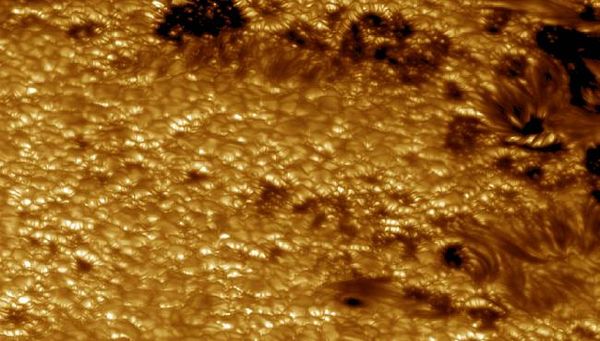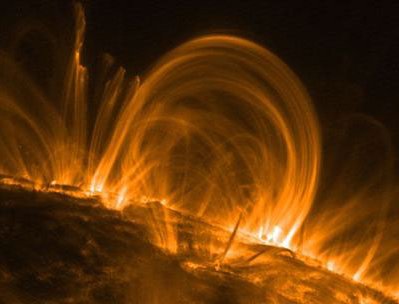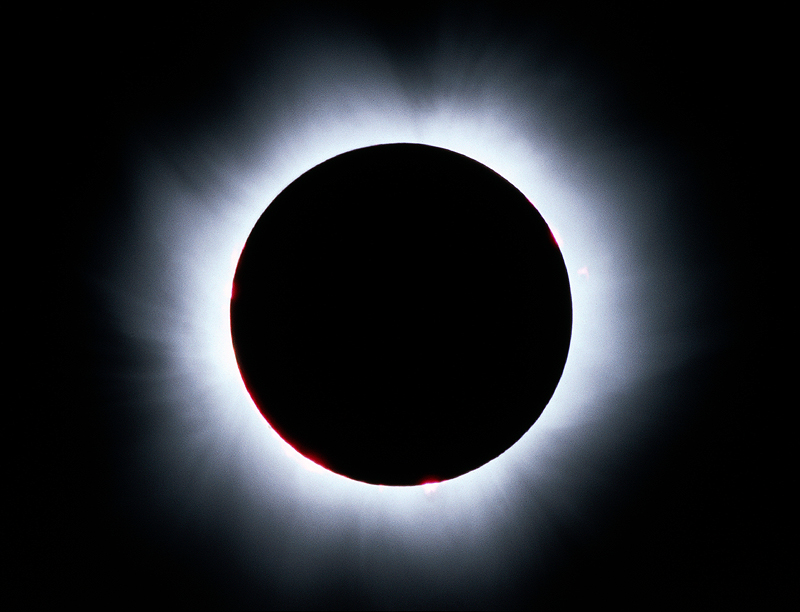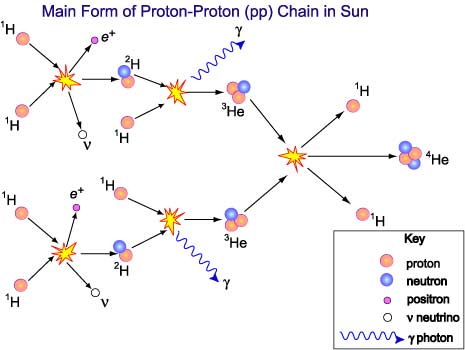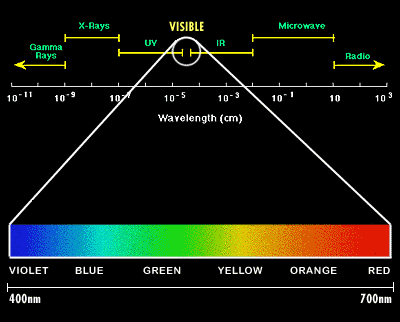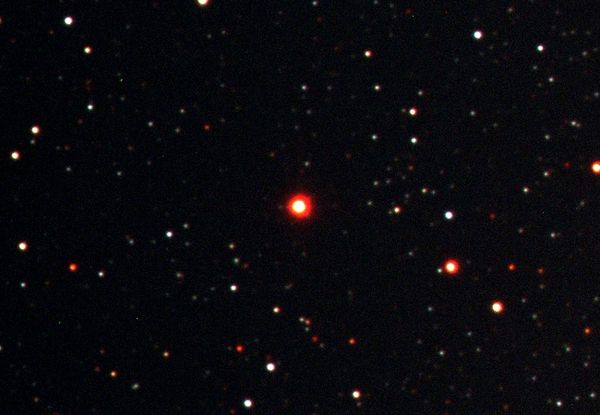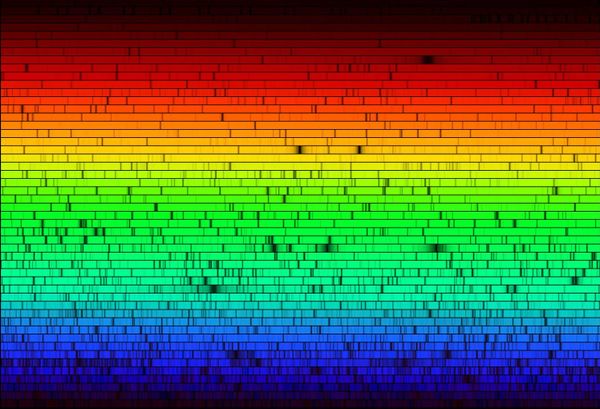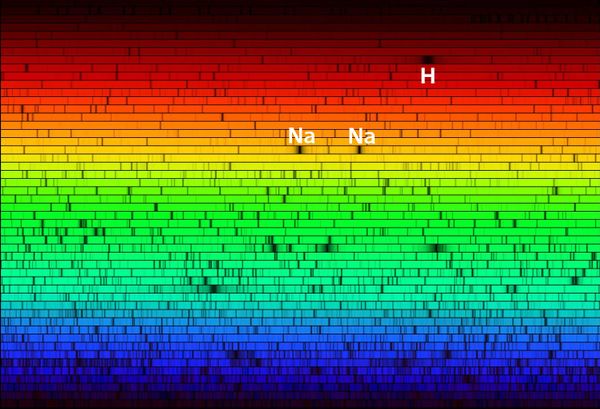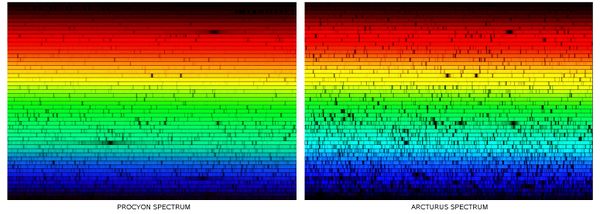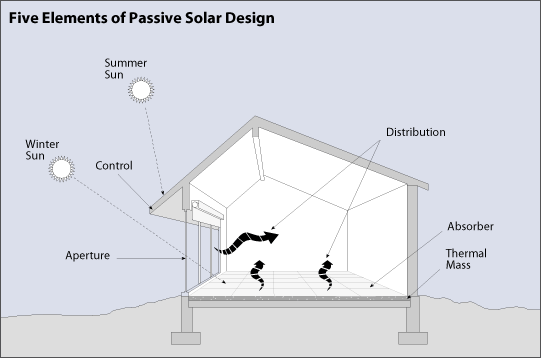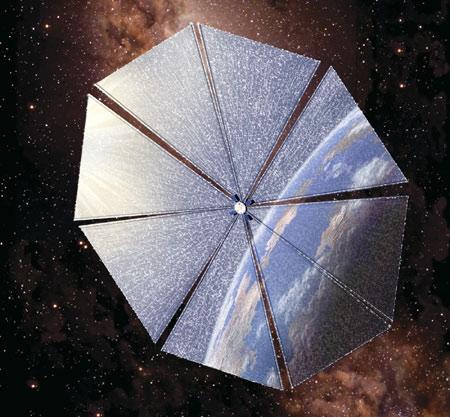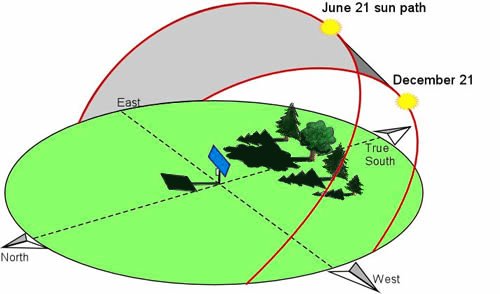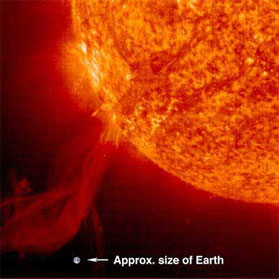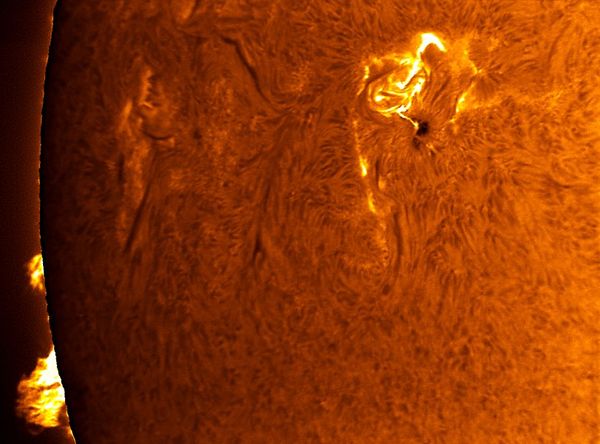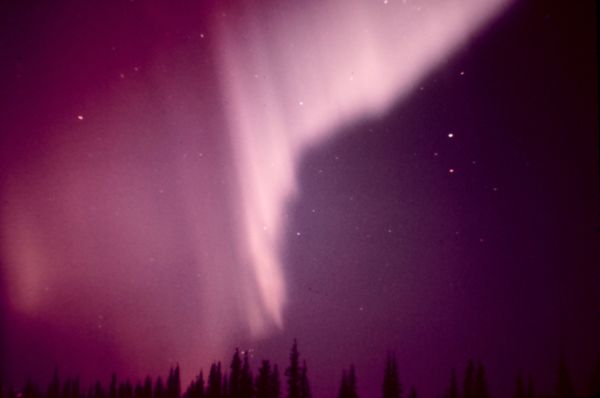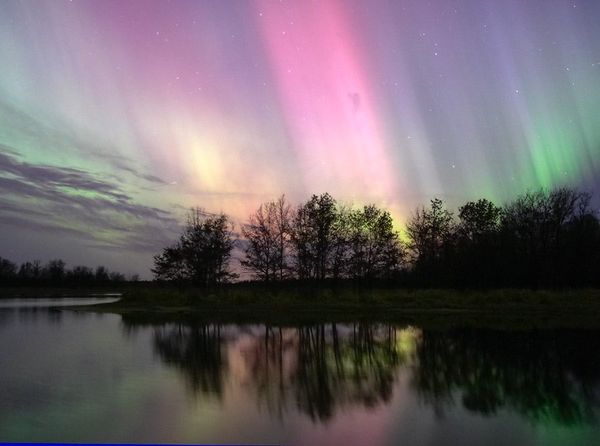The Sun Keeps Us Warm
The Sun's Temperature
In the near-vacuum of space, a molecule far from the Sun is warmed solely by light left over from the Big Bang. Absolute zero is −273.15 degrees Celsius (°C), −459.67 degrees Fahrenheit (°F) , or 0 kelvin (K). On this scale, the thin gas between stars may reach a temperature of only about 3 K. The Earth would be that cold too, except for some heat left over from its formation nearly 5 billion years ago, energy released from radioactive decay in its interior, and the energy it receives from the Sun. For the most part, it is the energy the Earth absorbs from the Sun, balanced by the energy it radiates back into space, that sets its temperature.
The Sun's surface, or photosphere, has an average temperature of about 6000 K. This temperature determines the flow of light from the Sun's surface, which is balanced by energy flowing out of its interior. Sunspots are cooler, at about 4500 K, because energy flow into them is blocked by a strong local magnetic field.
Note that the kelvin scale is Celsius plus 273.15. With the large numbers often discussed for the interiors of the Sun and stars, kelvin and Celsius round off to be essentially the same. The Fahrenheit scale is now used only in the United States, and there only for non-scientific use. We will use K almost exclusively in this course. On that scale, water freezes at 273 K (0 °C or 32 °F) and boils at 373 K (100 °C or 212 °F), and a warm summer day is about 300 K (27 °C, or 80 °F). The oddity that there is no degree symbol °, and that kelvin is not capitalized, is by international agreement. The term "centigrade", still occasionally used, is obsolete.
Specially designed telescopes on Earth and in space can show us the Sun's surface in exceptional detail by imaging the light that leaves the photosphere.
Sun's visible surface (photosphere). The smallest features are about 150 km across.
The nearly invisible chromosphere, just above the photosphere, is a little hotter than the surface with a temperature reaching a temperature of about 20,000 K.
Sun's chromosphere
Above the chromosphere, the corona becomes a wind of thin gas that flows outward through the solar system. The corona is remarkably hotter than the surface of the Sun, with temperatures reaching 2,000,000 K. During a solar eclipse, when the Moon blocks the light of the photosphere, the white glow of the corona is visible to the eye.
Solar corona during the eclipse of August 1, 1999
The average density of the Sun is about 1.4 grams per cubic centimeter. (If you were to fill a liter bottle with "sun stuff" it would weigh about 3 pounds here on Earth.) The corona is much less dense than the Earth's atmosphere, and even the photosphere is only about 1/1000th the density of our "air". Yet, as we move inward, both density and temperature increase. The center of the Sun is 15,000,000 K! The density there is 150 grams per cubic centimeter, and a bottle full would weigh over 300 pounds.
It is here, deep inside the Sun, that the energy that warms the Earth originates. It flows outward mainly as light, reaches the surface of the Sun in about 1,000,000 years after scattering around the dense gas, and then is free to arrive at Earth 8 minutes later.
You can read more about the Sun's other characteristics at these websites:
NASA's Solar Dynamics Observatory
The Sun's Source of Energy: Proton-Proton Chain
Deep inside the Sun, where the temperature is 15 million kelvins, hydrogen atoms zip about and often collide. Their energies are so high (temperature really measures how much energy each particle of a gas has on average), that a collision strips off the atom's electrons. Hydrogen, which is simply a proton and an electron bound together, is ripped apart. The gas at the center of the Sun is mostly hot protons and electrons.
At such a high temperature the protons have enough energy to overcome their repulsion (like charges repel) and fuse together into something more massive. Temperature is the key to make this happen, and the density is so high that it happens often. The reactions occur in steps, first making "deuterium", or heavy hydrogen, then making a light form of helium, and in the end making helium of the sort we find here commonly on Earth. During this process that makes one normal helium atom, four hydrogen atoms disappear from the Sun. You can follow the sequence of events in the figure, and read more about it in your text's Unit 50.
There may be many new ideas for you to think about here. The key point to remember is that hydrogen is turned into helium by fusion inside the Sun.
How many H atoms does it take to make one He atom in this process? Do a little counting and you'll see that the proton-proton chain consumes 6 H atoms, but it makes 2. So, the Sun converts 4 H atoms into 1 He atom every time the process occurs.
"So what?", you might ask. Here we do a little bit of accounting, adding up all the mass that is used to make the He, and comparing that to the mass of the He product. Some of it has disappeared. There's not as much matter in the He as we used to make it. This little bit of mass has been turned into energy.
Notice two photons of light are given off to make each helium atom. These energetic photons are called gamma rays (denoted γ) with energies 100,000 times photons of visible light. Much of the missing energy went into this light.
The Sun's Light
Gamma rays are absorbed and re-emitted by neighboring atoms, which changes their wavelength according to the energy levels of the electrons in the atoms, and the temperature of the atoms. By the time photons reach the Sun’s surface they mostly have wavelengths in the range of visible light (Type G star), with some ultraviolet light, infrared light, and small amounts of x-rays, microwaves, and radio waves. All these are forms of Electromagnetic Radiation, which is light, which is photons.
Light in the form of gamma rays, X-rays, ultraviolet, visible, infrared, microwave, and radio waves
The Sun is a Type G Star
We are fortunate the Sun is a medium-sized star whose electromagnetic radiation (“light” or “photons”) is mostly visible light, with small amounts of X-rays, ultraviolet, infrared, microwaves, and radio waves. Stars are classified based on the light that they emit, and those similar to the Sun (of which there are thousands known) are labeled type "G". We usually also add a number to the letter to indicate a finer division of the classification.
Earth's atmosphere absorbs energetic penetrating X-rays that could cause deep genetic damage. Ultraviolet light with wavelengths, more energetic than violet light, is mostly blocked by the ozone layer. Where there are holes in the ozone layer, such as near Australia, the incidence of skin cancer increases. Infrared light with wavelengths a little longer than red light, is felt as "heat" from a heat lamp. Any warm body gives off invisible infrared light. Microwaves have still longer wavelengths, that penetrate and cook food efficiently. Radio waves are photons with very low energy, long lazy wavelengths, that can carry music through space by changes in frequency and amplitude of the waves.
Why is the Sky Blue ?
The Sun is spectral class Type G2. This means that it has an average surface temperature of approximately 5,780 K, giving it a whitish color. Since the Earth's atmosphere scatters shorter wavelength violet and blue light much more readily than longer wavelength red light, the sky appears blue. The remaining light, the part that does not scatter, makes the Sun appear yellow.
Yellow sunlight in a blue sky
Type O Stars (Ultraviolet)
The largest, hottest, "normal" stars are called type O. They emit mostly ultraviolet light, beyond violet, that looks like a black light. (Recall bluer light is more energetic, and redder light less so.)
Alnitak is a beautiful star by the Horsehead nebula
The four bright stars at the center of the Orion nebula and beautiful Alnitak, shown here in the Horsehead nebula, are type O stars.
Type M Stars (Infrared)
The smallest, coolest, main sequence stars, type M stars, radiate mostly infrared light, like a heat lamp.
Proxima Centauri, center, with other, more distant, stars of different types.
Proxima Centauri, the nearest star after the Sun, is 4 light years from us. It is a type M star, the red star in the image above. All the other stars in the picture are farther away. They look faint because of their distance, but they are hotter and brighter than Proxima. We can tell a lot about a star by analyzing the light that it emits.
The Sun's Spectrum
Here is a spectrum of the sun's light, made when sunlight is dispersed into its components by a diffraction grating. An atom may absorb or emit a photon of light only when it can change by exactly the energy of that photon. Each element has a pattern of energy changes determined by the structure of its atomic electrons. Photons, originating long before in the fusion processes of the Sun's core, pass through the outer layers of the Sun, and are absorbed if their energies match the pattern of the elements present. The distinctive pattern of absorption lines identifies the elements present in the Sun, in distant galaxies, or even in gas in interstellar space between us and the source of light.
Solar spectrum
If a gas is heated, emission lines glow at these same patterns. We can use spectra to tell us the composition of nebulae too.
Solar Spectrum Reveals Composition of the Sun
The stronger the spectral line signatures, the greater the amount of that element. Spectral lines tell us the Sun is composed of hydrogen (H) (about 74% of its mass, or 92% of its atoms),
Hydrogen and sodium lines in solar spectrum
helium (about 24% of mass, 7% of atoms), and trace quantities of other elements, including iron, nickel, oxygen, silicon, sulfur, magnesium, carbon, neon, sodium (Na), calcium, and chromium. These heavier elements tell us the Sun is about a third generation star. In the early universe the first stars would have been made only of hydrogen and helium with a little lithium. All the common elements of our everyday world -- carbon, nitrogen, oxygen, silicon and iron -- are the products of fusion in stars that existed long before the Sun formed. The heaviest elements, nickel for example, can only be formed in the supernova explosions that ended the existence of the largest of stars in previous generations.
Can you tell the difference between the spectra of Procyon, a normal "main sequence" star, and Arcturus, a aging "red giant" star? Stellar spectra reveal not only the composition of a star, but also tell its temperature and how large it is.
Compared Spectra of Procyon and Arcturus
Free Solar Energy
Solar energy, derived from fusion deep inside, leaves the Sun in the form of photons of light, each a little packet of energy. The total energy emitted on the Sun's surface is approximately 3.85 x 1023 or 385,000,000,000,000,000,000,000 kilowatts (KW). 150 million kilometers away, the side of Earth facing the Sun intercepts some of the photons and receives about 43,700,000 KW of energy, that is, 1.4 KW or 1400 watts per square meter of the Earth's surface perpendicular to the Sun's rays. This 1400 watts/square meter is called the Solar Constant. A square, one meter on each side, illuminated by sunlight, has as much warmth as a 1.4 KW electric heater.
The roof of the average home receives enough energy from the Sun to power all of its appliances and to charge its occupant's electric car too.
Example: A 25' x 40' roof (1000 square feet) is about 9 square meters of area. Sunlight delivers 1.4 kilowatts to each square meter, or 1.4 x 9 = 12.6 kilowatts to the roof of the house. If, on average, there are 6 hours of useful sunlight a day, the home receives 12.6 x 6 =75.6 kilowatt-hours per day. Over a month this amounts to about 75.6 x 30 = 2268 kilowatt-hours.
The "kilowatt-hour" is a measure of energy. If you read your electric bill you'll see you are charged by how much you use in these units. An average American home requires 920 kilowatt-hours per month. Energy from the Sun is free, and in adequate quantity if we have the technology to use it efficiently.
Active Solar
The best of current active solar energy systems, where sunlight is converted to electricity, are still only about 23% efficient, but more efficient methods are being sought. Here is an example of a home actively converting solar energy to electricity with panels on its roof.
Solar Home with Photovoltaic Solar Panels
Passive Solar
Passive solar heating, in which sunlight is used directly to warm a well-insulated home, is close to 100% efficient. A square meter of sunlight, perpendicular to the Sun's rays, gives 1400 watts worth of free heat, the same as a 1400 watt electric heater. If someone knows how many 1400 watt heaters would heat their home, they need only place that many square meters of windows on the south side of their house to have the same effect. A correctly designed passive solar home may be heated for free.
Interestingly, the design of solar-heated homes depends on a knowledge of basic astronomy. You can see how it was done with a house in North Carolina in this short video. Large windows, porches, sun-rooms towards the south, invite in the low winter Sun. For a home that is insulated well, cooling can come from deciduous vines (Virginia Creeper is common in our area), and deciduous trees to shade the house from high summer sun. Since houses already have windows and trees, this adds no cost. Free home heating requires only the wisdom to do it.
A Simple Passive Solar Design
Basics of passive solar house design
The basics are large windows on the south side of a home, with overhangs or trees to keep out the high summer sun, heat storage, a way of circulating the heat, thick insulation, and a light colored roof. Rooms slightly below grade add geothermal insulation and cooling. Evergreens to the north, east, and west both shade in summer, and keep off winter winds.
More details about passive solar homes
Passive Solar Homes at Home and Abroad
The home shown below uses the elements of passive solar design with large overhangs and extensive south-facing windows. A solar water heater is at ground level on the right.
Kosmer House
Here are a couple of recent articles you might read. Think about how you would make a home of your own taking these principles into account.
The Kosmer 4,000 square foot home heated for $2.50 a day.
http://www.nytimes.com/2008/12/27/world/europe/27house.html?_r=1&emc=eta1&pagewanted=all Passive homes in Darmstadt, Germany, heated for $0.00 a day.]
The Sun's passive heat is now often used for water heaters, and with the same methods used in gas-flame powered refrigerators, it may run air conditioning as well. Very large scale power generation is possible by concentrating sunlight to boil water to run turbines, with much the same technology as in today's coal and gas power plants, but without the carbon footprint.
Sailing in Space with Sunlight
Sunlight, which may seem like gentle warmth to us, may someday reflect or "bounce" off giant mirror-like sails on spacecraft to propel them from Earth to other planets. Because there is no friction in the near-vacuum of space, the slight push from the pressure of light acts continuously, and a spacecraft with a solar-sail could steer an interplanetary trajectory without consuming fuel. Cosmos I, seen here, was the first attempt, but due to a malfunction of one of the combustion launch engines, it never made it into space. NASA's NanoSail-D unfurled the first solar sail in Earth orbit in January 2011.
Cosmos I
NASA NanoSail-D
Seasons
As everyone knows, the Sun is higher in the sky and the days are longer in summer, whereas the Sun is low in the sky and the days are short in winter.
Sun's Path at Summer and Winter Solstice in the Northern Hemisphere
Earth always tilts in the same 23.5 degree direction with respect to the background of stars. In the illustration below it is easy to see why summer days are longer, and the north pole has daylight all day long during the northern hemisphere's summer. It should also be apparent that when it is summer in the northern hemisphere, it is winter in the southern hemisphere.
Like a giant solar collector, where the ground is perpendicular to the Sun's rays, it gathers more heat. At the north pole, even in the summer with sunlight all day long, the temperatures are cooler because the sun's light strikes at a low angle, and its energy is spread over a larger area.
Seasons
In the northern hemisphere, around June 21st is the summer solstice, the longest day of the year when the sun appears highest in the sky . The winter solstice, the shortest day of the year, is around December 21st. The equinoxes are when the days and nights are of equal length, around September 21st and March 21st. It takes time for the Earth to heat up and cool off, so that the warmest days follow the summer solstice, and the coolest days follow the winter solstice.
Misconceptions about the causes of the seasons are common. It is easy to have a "Private Universe" in which we create our own explanations of basic concepts of science that are not quite correct.
Global Warming
Greenhouse gases absorb the energy that the warm Earth tries to radiate back into space, and alter the energy balance that sets the Earth's temperature. Carbon dioxide (CO2) and methane (CH4) are among the most significant components of the Earth's atmosphere that affect its temperature in this way. There is a seasonal change in these gases, but for several decades we have been measuring a steady increase in their concentrations attributed to burning fossil fuels, and to other industrial processes. Models of the balance of energy that the Earth receives from the Sun, compared to the rate at which it cools by emitting that energy back into space, show that the Earth's average surface temperature will rise at an increasing rate. Consequent shrinking of the north and south polar caps and glaciers is now well-documented. We can navigate ships across the north pole, and polar wildlife dependent on sea ice faces extinction.
Polar Bears Face Extinction
As the ice melts, the Earth heats faster, both because the ice had reflected away sunlight, and because energy that went into melting ice now heats the land and sea.
Mt Hood in Late Summer in 1984 and in 2002
Good news. The Earth can repair itself to some degree. When the ice caps melt, vegetation, that converts CO2 back into O2, can thrive where the ice has receded.
Bad news. Strip-mining, mountain removal, rain-forests cut for short term agriculture, subdivisions covering two thirds of urban land with asphalt, all prevent "self-healing" natural processes that would help to stabilize Earth's temperature.
Really bad news. Global warming can "run away." As the temperature rises, processes that increase the temperature accelerate. For example, with diminished polar caps the Earth absorbs even more solar energy. There are vast amounts of methane under the ocean that could be released if oceanic circulation is disturbed. Carbon sequestration, in which coal is gasified and the waste carbon is stored underground, is at best a temporary and unreliable solution.
Really really bad news. Venus, the closest planet to Earth in distance and size, has had runaway global warming. It is so hot, lead would melt on its surface. Spacecraft have landed there, to survive only a few minutes.
Hope? Controlling future carbon dioxide emission by using energy sources other than fossil fuels is the only known way to forestall disaster. Solar energy, either with direct conversion to electricity or heat, or with indirect wind and hydroelectric power, will be a major component of this rescue effort. Without this, the forecasts are grim. Power generation from controlled fusion, in which hydrogen from water would be converted to helium to produce unlimited supplies of clean energy, needs more basic research, is extremely expensive, and is decades away from production use. An international effort called ITER is underway.
Local solutions to a global problem. There are things you can do locally when you have an opportunity, or you can pariticpate in groups that foster regional actions to moderate the effects of global warming. Shade trees and underbrush create cooler mini-climates. Forests can be as much as 10 degrees cooler than the surrounding terrain. Lighter color on rooftops and roads reflect sunlight, reduce the effects of the urban heat island, reduce air conditioning costs. Turning off lights and applicances when they are not needed, and installing solar electric conversion panels, reduces carbon dioxide emission and the use of coal. New homes can be designed to heat themselves without fossil fuels, and to stay cooler, with high quality insulation. Reduction of urban sprawl through improved mass transit, redevelopment of the city core, and growth sensitive to greenspace preservation can reduce energy usage and improve the local climate.
Solar Wind
Shooting out from the Sun, in addition to light, are particles collectively called the solar wind. The solar wind consists mostly of electrons, hydrogen ions (protons), and a few helium ions (2 protons plus 2 neutrons). Its speed averages 400 km/s, but varies in from 300 to 900 km/s, just as winds vary on Earth. At 400 km/s it takes the wind about 4 days to reach Earth after it leaves the Sun.
Although there are only a few particles per cubic centimeter, it is this solar wind, that blows the gaseous tails of comets away from the Sun.
When the number of solar flares and sunspots increases, so does the abundance of solar wind particles. Sunspot numbers vary on a cycle of 11 years, and at times of high sunspot number, the solar wind can disturb the Earth's ionosphere, affect radio communication, and induce large destructive currents in electrical power distribution lines.
Sunspots and Solar Flares
About three or four days after a solar flare and sunspot activity, when an increase the number of energetic the particles reaches Earth, they are directed by Earth's magnetic field toward the north and south magnetic poles. There, they collide with Earth's upper atmosphere and create dynamic aurora that are widely visible at night.
Aurora
